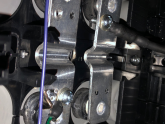Copper bus bars vs cable
- Thread starter BigVT
- Start date
Does it matter as long as they're properly sized?
And, is it important they're all the same length?
 nordkyndesign.com
nordkyndesign.com


That is good advice for motive applications like EVs and boats. Those BYD cells came out of EVs and that is a good example of why they do that.With regard to busbars and concern about expansion of cells being restricted, consider this:
Make your busbars from copper foil. .........If you look at the picture of the BYD cell connectors attached you will see this is what they did, using aluminum foil.
..............
A paper punch does a pretty good job if it is the correct size.You'll want to use a very sharp drill bit at very high speed using light pressure to get a clean hole drilled.


